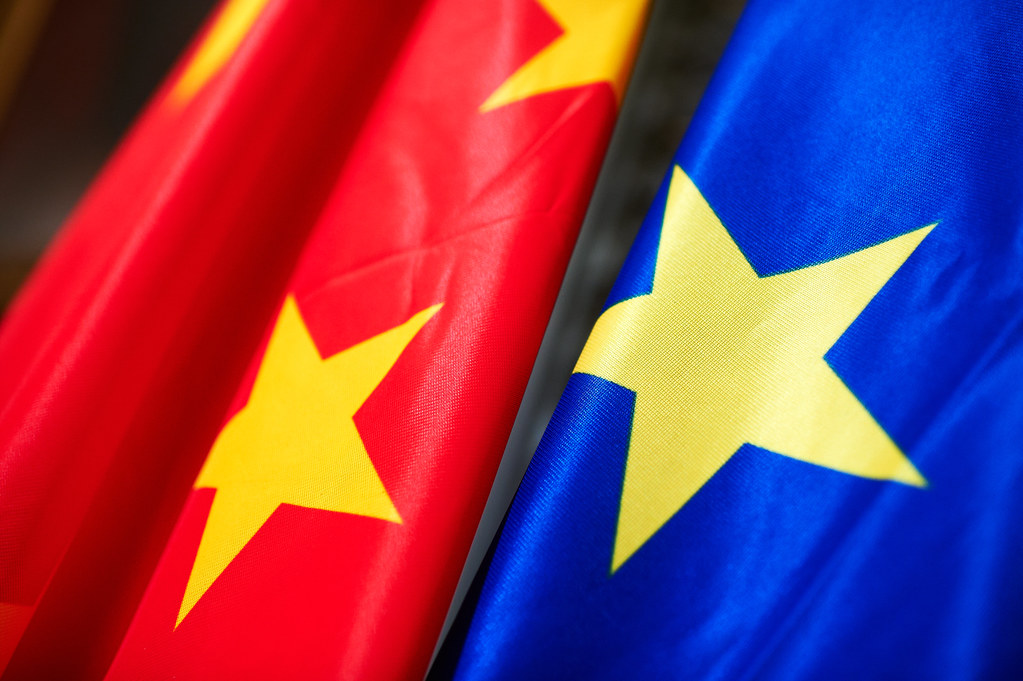
September’s special virtual meeting between the EU and Chinese leaders stirred once again a heated discussion about its outcome. The prevailing assessment was that tangible results of the meeting were minor if not non-existent. Similar assessments were presented after the 22nd virtual EU-China summit held in June. In other words, there is still a narrative that the EU is ineffective and naïve when it comes to China. Yet, it seems that it is better to look at the glass as half-full in this case as there are several arguments vindicating that the EU’s recent policy change towards China is not simply lip-service, but has actually already brought concrete results.
Towards the New EU China Policy
The EU is in the process of reinterpretation of its China policy that started already in 2016. The watershed moment was China’s takeover of German company Kuka, manufacturer of industrial robots. It was an example of implementation of Beijing’s “Made in China 2025” strategy that was announced a year earlier. This takeover, together with increasing interest of Chinese investors in Silicon Valley start-ups, made the EU aware of new potential threats coming from China, chiefly as regards critical infrastructure and high-tech industry. This served as an alarm bell. Since then, we can talk about the lingering process of sharpening the EU’s policy on China.
Changes are becoming noticeable. One may distinguish modifications on two dimensions: conceptual dimension, and the dimension of policy practice.
There are two important changes in the conceptual tier. The first one refers to the EU’s perception of China. Till 2019 China was generally perceived by the EU only as a partner, though a difficult one, with the two having been ‘strategic partners’ since 2003. In 2019, the EU’s perception of China changed dramatically. Now the EU looks at China through three types of lenses. Firstly, China is perceived as a partner, especially when it comes to global issues that could not be resolved without such a significant power as China, e.g. climate change, WTO reform and safeguarding and promoting multilateralism. Secondly, China is defined as an economic competitor in the pursuit of technological leadership. Thirdly, China is seen as a systemic rival promoting an alternative model of governance.
The second change within this conceptual dimension refers to the re-definition of the principle which serves as a cornerstone of EU’s policy towards China – reciprocity. For years the EU has called on China to respect and practice reciprocity which in fact meant convincing China to open its market and introduce economic (but also social, or maybe even political) reforms to become similarly open as the EU is. At the same time, the EU remained open for China. The result, however, was a growing asymmetry between China and the EU. In early 2019, the EU set out to redefine its understanding of reciprocity. Now, it is defined in the following way – in those areas in which China remains closed for the EU, the EU will close itself as well.
These changes in the EU’s perception of China presented above are reflected in practice as well. The first visible policy change refers to introducing protective and mitigation instruments and mechanisms mainly in the economic sphere. Among them are the EU-wide investment screening mechanism adopted in 2018, a toolbox to secure 5G networks adopted early this year, undergoing debate on the reform of public procurement mechanism (which means that Chinese companies may not take part in public tenders if Chinese tender market remains closed for EU’s companies), new and better EU industrial policy, a toolbox on AI, limits for state-owned companies and those that receive governmental subsidies to invest in the EU, reports on disinformation calling out China, increasing support for building EU’s strategic autonomy in the digital sphere, just to name a few. Moreover, the EU set about setting deadlines for China (e.g. on a Comprehensive Agreement on Investment (CAI) or geographical indicators agreement), as it was the case at the EU-China summit last year. Moreover, Brussels made it clear that without China’s concession, CAI would not be concluded. Clearly, the EU is now focusing on the substance of a treaty, not its time horizon.
The second visible change refers to the normative issues. The EU as both an economic and normative power is becoming more openly outspoken when it comes to human rights issues and international law. The best example is the EU’s open criticism about the situation in Hong Kong, especially since the adoption of the controversial national security law. The EU is also very concerned about seriously deteriorating human rights situation in Xinjiang and Tibet. Apart from oral criticism, the EU is working on its version of the Magnitsky Act, partly motivated by China’s actions, that could be used to sanction officials responsible for the abuses, as the US has done before.
The Pillars of the New Approach
First of all, it is clearly noticeable that the EU China is focusing on its own resilience in its relations with China, which seems to be a reasonable approach. If the EU cannot change China, the only way is to protect itself. Although this is, in fact, defensive, it is worth appreciating the real change that is taking place in the EU. The EU is becoming slightly protectionist but with a clear goal – to defend itself and place its own interests first.
Secondly, despite the fact that there have still not been any substantial concessions from Beijing, especially when it comes to the economic dimension such as market access (but obviously also in the normative area), the EU’s consistent tougher approach makes China unable to achieve its two main goals. The first goal is to maintain the status quo, which China really appreciates – an open Europe for China economically and silent Europe when it comes to human rights and other sensitive issues for China. The second goal, especially since Trump came to power, is to prevent EU-US cooperation against Beijing.
In case of the first aim, the EU is becoming increasingly resilient. Meanwhile, in the case of the second goal, the US-Europe cooperation on China is slowly becoming a reality, with official bilateral dialogue on China in a planning stage. If Biden wins the upcoming presidential election in the US, the chance for meaningful transatlantic coordination on China is likely due to his possible softer approach to the EU, as compared to the confrontational policy of Trump. Chinese nervousness about the EU and US getting close together is betrayed by statements in the Global Times (the Party’s mouthpiece) such as “Europe has no other option except for strengthening pragmatic cooperation with China” or “Europe’s hard stance toward China has strategic limitations”. These are perverse examples of Chinese anxiety. Similarly, the positive assessments of the September China-EU meeting results from Chinese MFA and Xinhua are nothing but a smoke screen. In other words, if you need to persuade others that something is going well, it usually means the exact opposite…
Thirdly, China hates the term “systemic rival” and was surprised by the publication of “EU-China: a Strategic Outlook” in 2019. Chinese experts openly admitted (author’s personal experience) that in 2020 China must respond to the new approach of Brussels. Beijing was preparing for a diplomatic offensive in 2020, taking advantage of momentarily improved ties with the US after signing the “phase-one deal”. The pandemic and China’s confrontational foreign policy, particularly in Europe (including disinformation), have changed those plans. Paradoxically, China’s abrasive policy made the EU more united and convinced many leaders that the PRC is a real rival and threat.
Fourthly, it seems that the EU has drawn a lesson from the past especially when it comes to internal division– the biggest problem when it comes to China policy. Despite existing differences, there has been noticeably better coordination between different EU institutions and also between the EU institutions and the member states. This is evidenced by putting China on the agenda of the European Council (e.g. for the first time in March 2019, before EU-China summit, and recently during a special European Council in early October) and ministers of foreign affairs meetings (before 14 September virtual summit), as well as mentions of China in Ursula von der Leyen’s inaugural State of the Union address.
What is more, the German idea of organising the so-called 27+1 meeting with China, a summit with the attendance of all 27 Member States on the side of the EU, despite some doubts about its effectiveness, is also an attempt to demonstrate the EU’s unity and strength. It seems that paradoxically, the 17+1 format of cooperation between China and Central and Eastern Europe, harshly criticised by Brussels for dividing the EU in a “Trojan horse” strategy, made the EU realise that CEE interests in relations with China should be taken into account more seriously.
Moving from Reactive to Proactive Approach
Even though there is still no noticeable progress from the Chinese side on meeting the EU’s requirements in bilateral relations, the EU’s new stance is worth appreciating on its own. Making China uncomfortable with the manifestations of the EU’s unity and sharper course during the special leaders’ meeting on 14 September and few days earlier during Wang Yi’s visit to five European countries (e.g. firm stance against limiting autonomy in Hong Kong, harsh criticism about what is going on in Xinjiang, or solidarity with Czech Senate president who visited Taiwan) is a real step forward. At the China-EU leaders’ meeting, Ursula von der Leyen said that China must convince the EU that the investment agreement negotiations are worth concluding. Now, the ball is in China’s court.
Still the EU’s China policy remains reactive and defensive, rather than proactive in agenda-setting. In that sense there is much work ahead of the EU. Still, it is better not to be blind to the progress the EU has already made. Examples of solidarity, better coordination within the EU, principled and hard stances on normative issues, and consistency in implementing tougher policy towards China are real challenges to Beijing. After effectively introducing a set of measures to protect ourselves, there would be a time for the EU to work on an active agenda.
For sure, this approach will be much more difficult to “invent” and implement than the defensive one. Yet, if it succeeds, it would be real evidence of the EU’s strength and its role as a great power.
Written by
Justyna Szczudlik
ShilinabolanJustyna Szczudlik is the deputy head of research, a China analyst, and the former Head of Asia-Pacific Program (2016-2021) with the Polish Institute of International Affairs (PISM).


